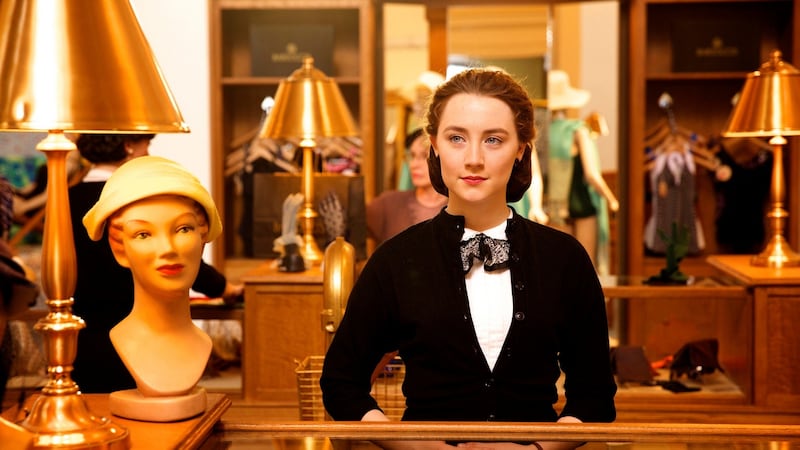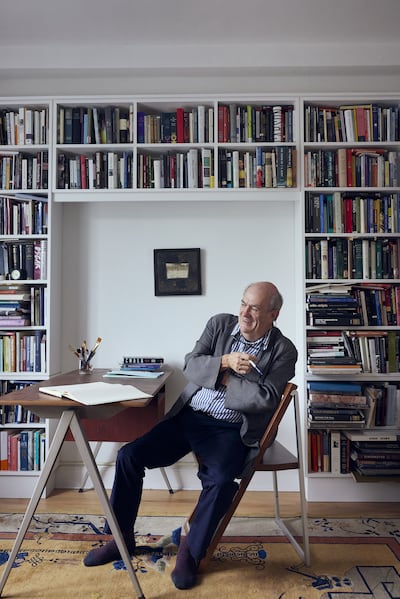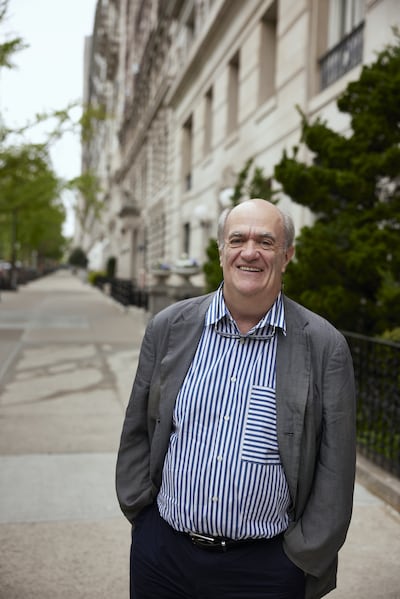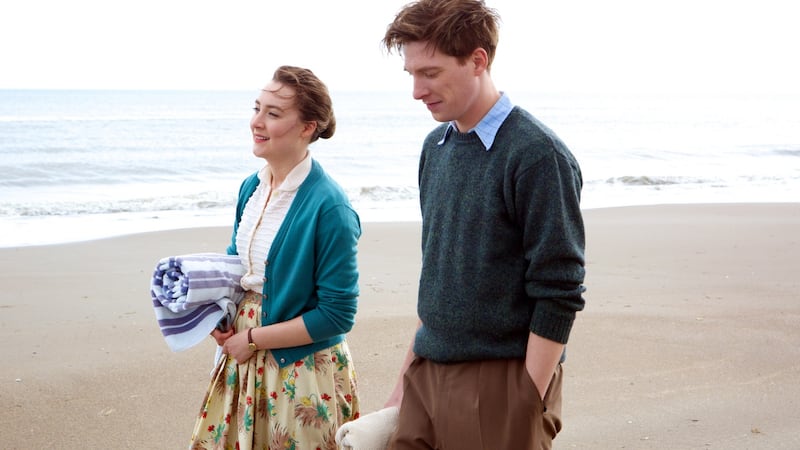When Mayo and New York met for this year’s Bronx episode of the Connacht senior Gaelic football championship, among the more unexpected faces in the crowd was Colm Tóibín.
For almost a century, the small stadium has served as a portal to home for generations of the resident New York-Irish, for whom the summer visits of the big GAA stars once held the power of a hologram. Ease of travel has diminished the psychic distance between Ireland and the US, but Gaelic Park remains a vivid experience: an instantly familiar Irish sports scene apart from the subway train rattling by, the baseball diamond and the blazing sunshine.
It was sunny on the Sunday in early April when 5,000 Mayo fans turned up as their team enjoyed a comfortable win. It was Tóibín’s first visit, in the company of students in Columbia, where he teaches a course in English literature every spring semester.
“It wasn’t a case of wandering up on my own,” he says when we meet in the Simon & Schuster building, a 6th Avenue architectural landmark since 1939.
READ MORE
“I went with the students and brought along a fellow novelist from Boston. But it was just wonderful. First of all, just watching Gaelic football – the speed of it and sheer intensity of it is not like anything else at all. And the numbers of Irish. It wasn’t anything old-fashioned or anything that would remind you of the ‘50s. This was modern and this was ‘now’, and it was a big football match. I was fascinated by it. I suppose the natural way the crowd dealt with it and just the whole sense of it ... It wasn’t in any way to do with nostalgia. Everyone took it as par for the course that there would be a Gaelic football match in New York. And I just felt I have written these books and I need to pay attention to this.”
These books, indeed. His curiosity was partly informed by his return, in his latest novel, Long Island, to the once-teeming world of the Irish immigrants who swelled the Irish enclaves of the five boroughs in the second half of the 20th century, making lives there and recreating Ireland in exile.
It’s a return also to Brooklyn, his beloved 2009 account of Eilis Lacey, a quiet if steely young 1950s Wexford woman who joins the masses in setting out for New York, slowly adapting to its distance and alien sounds and its overwhelming strangeness. She thrives. A secret marriage occurs. After an unexpected return home, she is torn, throughout one of those long cider-coloured Irish summers, over the consequences of whether to return to this newly created future in New York and thus leave home – and a significant love – behind her for good.
[ Long Island by Colm Tóibín: Brooklyn sequel brings Eilis back to EnniscorthyOpens in new window ]
The story was in part an ode to a vanished generation of Irish as well as a classic love story. The 2015 film treatment, also called Brooklyn, was nominated for three Oscars, including for Best Picture and Best Actress, the latter for Saoirse Ronan’s uncanny embodiment of a particularly Irish mid-century femininity. Part of the wistful appeal, for reader and viewer alike, lay in wondering what became of Eilis Lacey, in much the way as Irish families for decades wondered about those departed sons, brothers, sisters and relatives who made that journey and often kept in touch through letters, occasional phone calls or not at all. In writing Long Island, Tóibín knew he was answering many of those questions – and that carries a certain risk.

“Yeah,” he nods, his eyes widening at the suggestion as he leans back.
“The risk is ... I suppose it is called cheapness in another way,” he says and immediately laughs, speaking rapidly as he warms to the theme.
“You know, you have a novel [Brooklyn] and it certainly sold more copies than anything else I have written. And I never wanted to do a sequel and just carry on. Because if you wanted to say that, well: why didn’t you say it in the novel in the first place? I had some idea. But not much. But nobody in here” – he waves his hands to denote the Simon & Schuster building – “ever said, when I was giving them novels about you know, The Testament of Mary [2012] and Thomas Mann [The Magician, 2021] and ancient Greece [House of Names, 2017], no one ever said – they are good like that – nobody said would you not think, you know, of giving us a novel that you might, you know ... There honestly wasn’t pressure from anyone, ever. What happened was that I got the idea for the opening. And I realised then I could write a new novel. Once those three pages are there, the novel is not a sequel to Brooklyn but a sequel to what happens on those three pages.”
[ Colm Tóibín sells Thomas Mann back to the Germans. Not everyone’s buyingOpens in new window ]
Any written interview with Tóibín should really carry the requisite of an audio recording because the entire point of any conversation with him lies in how he communicates through his voice. He’s a warm, natural talker with a sometimes audaciously theatrical delivery, moving from low whispers to guffaws, from broad smiles to startled looks when he voices a thought that catches him unaware.
The title for Long Island lodged in his subconscious years ago when he was in the choir of a Catholic church on the Upper West Side of New York. The building was filled with Irish names – long-gone priests and parishioners – and in the presbytery afterwards, he asked someone where the Irish would have headed after they were priced out of the upper reaches of Manhattan. The answer he received: “Ah, they went out to Long Island.”
And that information stayed with him when he was writing Brooklyn, in the scene where Tony, Eilis’s Italian-American husband, is wooing her with a vision of their future by bringing her to a greenfield site and asking her to imagine.
“And I remember when John Crowley was making the film, he asked me was there one moment I wanted to do something with. I just said, Yeah, could you look at that moment where the two of them are on the greenfield site and he will show her where the infrastructure will come? And I didn’t think about it any more. And what John did in the film was he moved it out and out and out so you could see the two of them in a sort of panorama.”
I write in longhand, and I have to put every word down again. So, it was constant. Take that out. Stop saying big things! Bring it down
— Tóibín on the year he spent editing Long Island
Long Island opens with Eilis and Tony now parents to teenagers and in the throes of a marital crisis. It’s shortly after the Nixon resignation, and they are an immigrant couple in the messy, accelerating 1970s. When Tóibín wrote Brooklyn, he said that it was the first time he ever had the confidence to just take a character and trace the linear progression of her journey. When he wrote The Master (2004), a fictive account of a crisis moment in the life of one his literary idols, Henry James, he followed, as he wrote in a Guardian essay, “the shape of James’s life”.
He tells a very funny story in that essay of a summoning to meet Bernardo Bertolucci, the revered Italian film-maker who claimed he was interested in making a film of the book. As they spoke, Tóibín writes in the essay, Bertolucci told him that he particularly liked a scene in Venice, “when James and a gondolier tried to ‘bury’ the clothes of fellow writer Constance Fenimore Woolson in the waters of the lagoon. In fact, he liked it so much that he just wanted to make a film of that. ‘The rest has no story,’ he said dismissively. The novel followed the shape of James’s life. It did not, as Bertolucci so kindly put it, have an actual story.”
Long Island is a very different territory. From the beginning, Tóibín understood he had a tightly calibrated, plot-driven story on his hands. To avoid spoilers, it is enough to say that circumstances hasten Eilis’s return to Enniscorthy, with her children in tow. The majority of the novel takes place in the town she left behind. An observation Tóibín has made is realised once more here: once the exile returns home, be it from abroad or a term in boarding school, the life made elsewhere immediately disintegrates and becomes a hazily remembered dream. Back in her childhood home, with her still-sharp, resourceful mother, Eilis renews acquaintances with the people left in her wake in the years after Brooklyn. Here is her friend Nancy, widowed now. Here is Jim Farrell, unmarried, running the family pub. Everywhere is the ghost of her dead sister, Rose.
“I had an old-fashioned plot. An action that carries consequences. And because I am working up above [he means Columbia University, about 50 blocks north], I’m around a lot of theorists of the novel and I have a colleague who wrote an essay on plot, and I just happened to be reading about it. A plot is an action, and you need consequences that must be then told. And the consequences are not predictable. But a plot is not really the action. It is not good enough. It is that old-fashioned idea that you simply let off a sort of explosion. It is how you then get everything back together.”
He completed the book more than a year ago, but the decision was taken to hold publication until now.
“I had a year with it,” he says gravely, meaning he couldn’t leave it alone. Instead, he had endless nights with which to pare and further pare a style and tone that is plain and deceptively simple. He developed the habit of printing the manuscript out, reading it over and over and eliminating anything that he could.
“Anything that brought it down. Down, down, down. And if you do that, you find words and paragraphs, and endings and you just bring it down and down. Does this sentence do the work it needs to do?”

He thinned the finished novel by a further 12,000 words through that process. But it was more than that: it was also examining the strict boundaries he set himself in his portrayal of Eilis, who herself uses language sparingly. He explains his reworking of a brief scene in the opening pages, where Tóibín has let the reader know that Eilis has discovered something about Tony, and is furious as she goes through the charade of cooking the evening meal and considers pouring Tony’s dinner on to his lap.
“She has to let Tony know she knows. She can’t say it. So, then I thought: will I get away with tilting the plate. How would I get away with it? She didn’t remember what order she would do it. No shaking. No blushing. No ... feeling! So, you don’t give – ‘she felt for a moment that she could hit him over the head with a brick’ – don’t put in that sentence. It has to be all from her point of view but only what she did.
“And then you read that and that tilting the plate ... is wrong. It is too dramatic and also too visual. Am I trying to get something from a movie? Do I need to bring it down another notch? But she can’t just ‘shoot him a look’. Because I can’t use ‘shoot’; it’s a metaphor. As she turned she caught his eye ... nah. Uuuggh! And you go through every possibility. And you read it at night, and it seems good. You read it in the morning, and it seems awful. I write in longhand, and I have to put every word down again. So, it was constant. Take that out. Stop saying big things! Bring it down.”
That New York energy, I don’t really get it. I live on Riverside. It’s quiet. It is really like a university village. It is a very quiet, nice life but it is where I want to be
This brings out another loud cheerful laugh as he relives the torture he puts himself through. At one stage, Nan Graham, the senior vice-president at the publishing house and his long-time editor, comes in to say hello. “Are you guys discussing Yeats?” she asks cheerfully, and Tóibín appears momentarily surprised before replying, “No. We are discussing gossip and secrecy in Irish towns. A subject you might know something about at this stage.”
“More gossip and more silence!” she says, laughing.
Graham has edited and worked with Tóibín since he published The Heather Blazing in 1991. “Then she moved here, and I came here too. It is unusual.”
She tells him an old friend is waiting to say hello. Through his writing and lecturing, Tóibín has a long association with New York but says he is not dazzled by it “in the same way as other people. Not really. I mean, I like where I live but I have never really ... that New York energy, I don’t really get it. I live on Riverside. It’s quiet. It is really like a university village. There are glamorous restaurants, I suppose, downtown. But it is mainly students there, so it is confined. It is a very quiet, nice life but it is where I want to be.”
[ Colm Tóibín on testicular cancer: ‘It all started with my balls’Opens in new window ]

Still, when asked about his first visit to the city, his recollection is sparklingly clear and quick. It was 1989 and he had been sent by the Sunday Independent to write about the changing face of St Patrick’s Day. “An Aengus special,” he says brightly, a nod to the late editor Aengus Fanning.
“It was clear to us that something new was happening in Irish-America, particularly New York. A new group had arrived, and they didn’t want any truck – it wasn’t Noraid, it was more that the Friendly Sons of St Patrick and the general ethos of St Patrick’s Day was too conservative and too strange for them. For example, the dinner was men only. So, there was a split. The new Irish took over a Puck building in Soho. It was fashionable and there was a jazz band, and no green anywhere. There was no sense of the shamrock or greenness. And it was very modern. I ended up marching that day with Donie Cassidy and Albert Reynolds, I mean it was the strangest thing. But that was part of my job. And that was my first time in New York.”
Elsewhere, he has written about that maiden visit of his joy at bagging a $5 standing-only ticket for a Wagner opera at the Met, then discovering a free seat before ringing his friend’s number to find that he had, as arranged, left on his answering machine a recording with the name of the bar where Tóibín could find them. He took a midnight cab to McManus’s on 7th Avenue, where they drank until 5.30am, finishing the evening with the garbage men who had finished their shift.
That world, of telephone boxes and second-hand communications and arranged meeting times and places, are part of the intricate mechanics of Long Island. Although Eilis is the heroine and moral heart of this novel, Jim Farrell, in a curious way, steps into the foreground as the story goes on. There’s a haunting sense in Farrell of a life suspended during the two decades Eilis has departed and one of the intrigues of the story is their attempt to defy the fates and the probability that their time has come and gone.

“Yeah. I got a lot of inspiration from Domhnall Gleeson’s performance [in Brooklyn]. And I wrote to Domhnall at the time. It is very difficult to represent a very quiet Irish man. It is so much easier to represent a clown, a chancer, a drinker, someone who is dark, who has got anger. Jim just gets on with it. He is utterly straightforward. Everything works. Except he just missed out on things. And he doesn’t have a group of friends. And I found much of that in the way Domhnall played him.”
In the days after we meet, Tóibín flies across to Los Angeles, where he lives for part of the year. The glamorous surface life disguises a monastic devotion to work. You get the sense from Tóibín that when he is not chatting with his sense of mischievous energy, much of his time is spent in stillness and silence. But the role of raconteur comes naturally, and the starlight memory means he can instantly, in conversation, bring the listener back to his hectic days as editor of Magill or his childhood or the summer he spent traipsing along the Irish Border for the brilliant Bad Blood. He’s an avid newspaper reader still and has seen the headline, earlier that day, that the Slieve Russell, once the showpiece of the Seán Quinn empire, is up for sale. Quinn hosted Tóibín in his office when he called in unannounced.
“And he was a quiet-spoken, modest fellow. There wasn’t a single flourish in any way except for the Financial Times on the table,” he says of their meeting. The hotel opened, to general wonderment, in 1990.
“The Slieve Russell was an extraordinary sight. You turned a corner at a place where you thought at any moment there would be British soldiers or nobody, and then ... this extraordinary building. As a piece of architecture, it is sensational. It would just shut everyone in Dublin up for a while. And it was where the weddings could happen and the golf course ... A lot of people worked there. And it all goes to show that there is no such thing as a stable character.”
The idea of someone like me knowing anything about what 10 and 100,000 people might do in Arizona or Pennsylvania is just absurd. I simply haven’t a clue
— Tóibín on US politics
That observation could as easily apply to Long Island as its outwardly steadfast characters grapple with internal fluctuations of heart and soul. The novel will keep Tóibín busy, with readings scheduled across the United States and in Ireland. It’s also an Oprah book club pick, guaranteeing it attention. On the day we meet, Mike Johnson, the speaker of the House of Representatives, makes an impromptu appearance in Columbia, delivering a stern and scolding speech warning the pro-Palestinian protesters to disperse, an ominous visit that presages the uncompromising national crackdown and forcible removal of college protesters across the United States.
“Everything is not what it looks like,” Tóibín says that afternoon about Columbia. “The hysteria is being created by the university authorities. We had riot police but no riot. The student protest was confined to a very small area and very peaceful. I am getting final term papers now, but I am also getting emails from students saying they are having a terrible time because of how the university has handled all of this.”
This is, he acknowledges, a fractious moment in the US. He smiles when reminded that after the Obama election in 2008, he made an appearance on Prime Time and likened the euphoria he sensed in the United States to “a city on a hill”. That was then. After wrongly asserting that Donald Trump would not be elected in 2016, he came to the decision that for all his travels across the republic for readings and various collegiate engagements, he could not hope to know the mind of Americans – including the descendants of Eilish Lacey’s generation of emigrants.
“Yeah. The idea of someone like me knowing anything about what 10 and 100,000 people might do in Arizona or Pennsylvania is just absurd. I simply haven’t a clue. And I think people like me should be really, really quiet, and ashamed of themselves after 2016. I just think it is time ... to be silent.”
Long Island is published in Ireland and the UK by Picador Books on May 23rd. Colm Tóibín will be reading at festivals in Dublin, Galway, Belfast, Borris, Co. Carlow, Dalkey, Bantry and Dingle: see colmtoibin.com



















